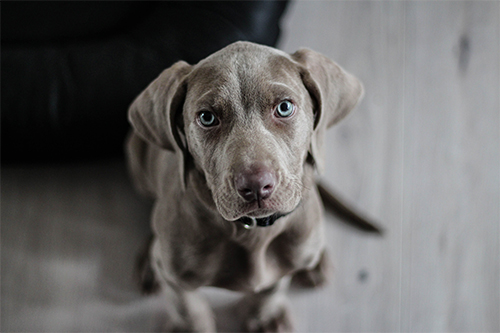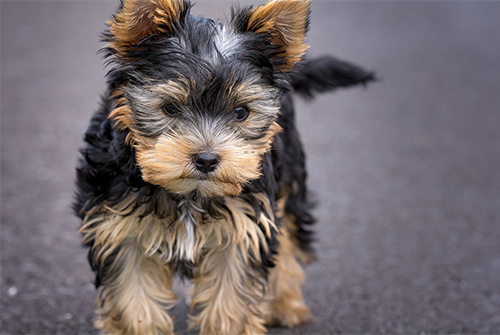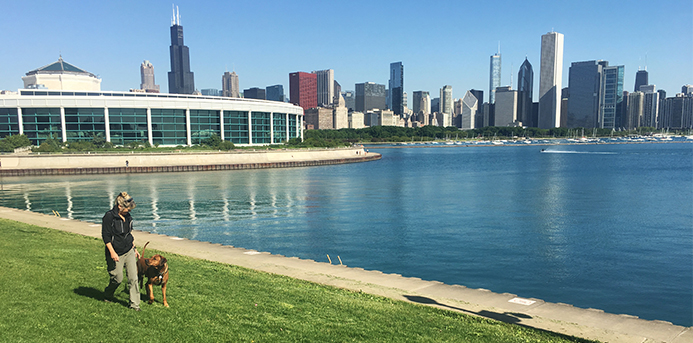Training doesn’t stop after puppy school graduation. From potty training to pulling, there are simple things you can do to redirect bad behavior and turn your troublemaking tail wagger into the ultimate good dog. Five trainers weigh in on the top dog problems they see — and what you can do to stop them in their tracks.
1. Housetraining
“Housetraining is all about creating a habit in your dog. Dogs will go to the bathroom wherever they go the most (hopefully that’s outside). Help them learn this habit by taking them outside frequently, rewarding them when they go to the bathroom outside (which means you’ll need to watch them outside) and restricting their freedom in the house to only rooms where you can watch them (so you can hopefully catch them while they are sniffing for a good spot and take them outside before they go)! Constant supervision and frequent trips outside for a few weeks will help your dog to form good habits. If they have a habit of going inside the house, try restricting their access to the spot where they usually go.” — Robin Bennett, CPDT-KA, Author of “All About Dog Daycare,” Chair, Association of Professional Dog Trainers Board of Directors
2. Pulling
“Long walks are great — but not when you are teaching your dog to stay at your side! Start by walking slow, keeping the leash loose. As the dog moves in front of you, turn and walk in a different direction. Walk your dog in a predictable area (i.e., only on your street near your home) when conducting this exercise, and spend at least five minutes a day training your dog in this manner. It pays off in dividends!” — Marlene Marks, Dog Behavioral Therapist and Trainer, Bark Busters Home Dog Training

3. Barking
“Dogs bark to communicate just like we talk to express our thoughts. A valuable approach to begin with problem solving excessive barking concerns is to ask, ‘What is the function (the purpose) of the barking behavior?’ Then, notice the absence of barking. If your dog barks at noises in the hall or outside, observe when you hear a noise and they don’t bark — treats! Reinforce less intensity of the barking behavior. If you observe your dog alert to a sound (tilt their head, look toward the sound or sight of the distraction) — treats! If your dog sees another dog on a walk at a safe distance and does not bark — treats! Then walk farther away from the other dog to provide space and plenty of sniff time at a relaxing distance. At home, turn on the radio, television and a white noise machine to help mask the sounds outside. Don’t yell at your dog while they are barking. You are barking with them, creating a higher arousal level, and reinforcing the barking behavior.” — Laura Monaco Torelli, KPA CTP/Faculty, CPDT-KA, Fear Free Certified Level 2, Animal Behavior Training Concepts
4. Jumping
“Dogs jump up on people out of excitement. If your dog does this to you or other people, it’s because he wants attention and doesn’t know how to control himself when he is that excited. You must show your pup that jumping up isn’t how he gets attention, but sitting calmly in front of you is how he gets attention. If your pup attempts to jump up on you, tell him ‘OFF.’ Turn your body so that your back is facing your dog. When you move your body this way, your pup will automatically put his paws back down to the floor (where they belong). Turn to face your pup again and redirect him to sit. Once he sits, pet him and show him THIS is how he gets your attention. If he starts jumping up on you again, stop giving him attention and repeat the steps above. Only give your puppy attention and affection when he is sitting. Practice this routine until it becomes a habit.” — Kaelin Munkelwitz, Owner/Head Trainer & Behaviorist, All Things Pups

5. Inconsistency
“It is very common for people to expect their dogs to know or understand things that we may not have reinforced enough or sometimes we haven’t even taught them what it is that we would expect or want from them. It also takes a lot of repetition to ensure that the dog is fluent in our word and expectation. I equate this to language, as this is certainly a different language for our dogs. If we were to become fluent in another language and be confident enough to not just speak it at home, in the classroom, or conversationally, but as an immersed member of that culture, we would need a lot of coaching and repetition. The same is true of our dogs. Your dog need repetition and follow through.” — Alexa Kehoe, Owner and Head Trainer, Sit Means Sit Chicago

Lindsay Roseman, formerly Make It Better Digital Editor, is a Chicago-based writer, editor and lifestyle blogger living in Old Town. When she’s not blogging about her current favorites on What Lindsay Loves, she’s looking for the best new thing in fashion, beauty, food and entertainment — or she’s probably running (training for her first Chicago Marathon). Other things Lindsay loves: banana lattes and small dogs (she’s a dog mom to @LylaTheCockapoo). Her work has also been published in CS, NS and Women’s Health magazines.

